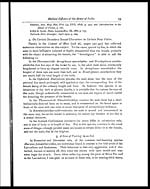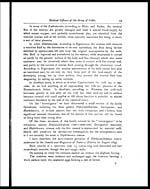Medicine - Institutions > Army health reports and medical documents > Scientific memoirs by medical officers of the Army of India > Part XII, 1901 > 3 - Zoological gleanings from the Royal Indian Marine Survey Ship Investigator
(86) Page 54
Download files
Individual page:
Thumbnail gallery: Grid view | List view

54
Scientific Memoirs by
On one occasion I encountered a male and female in copula, in a hole in a
coral-rock, and captured them, the male biting savagely, though not quitting
his hold of the female. The edges of the vent and genital pore of the female
were found to be swollen, everted, and inflamed, with eggs protruding from
the pore.
De Joannis (Revue Zoologique par la Societe Cuvierienne, 1839, p. 52) states of
Anguilla that they are frequently found in swarms, when he believes that they are pairing.
See also an abstract of a paper De anguillarum sexu et generatione, in Müller's Archiv,
1843, p. ccliv.
On the pairing and sexual behaviour of fishes see Darwin, Descent of Man, the section
of Chapter xii on secondary sexual characters in fishes. Also Bolau, Zeits. Wiss. Zool.,
XXXV,1881(pairing of Dog-fish).
Carbonnier, Ann. Mag. Nat. Hist. (5), VII, 1881, p. 73 (pairing of nest-building
Cat-fish—Callichthys fasciatus).
Blum, Zool. Garten, XXIII, 1882, p. 124 (pairing of Zoarces viviparus).
Guitel, Arch. Zool. Experim, (2) X, 1892, p. 499, and (3) I, 1893, p. 326 and p.
611, and (3) III, 1895, p. 263 (Gobies and Blennies)
Holt, Proc. Zool. Soc. 1898, p. 281 (pairing of the Dragonet).
6. On Viviparous Bony Fishes.
Exclusive of the numerous nutricant species that guard the developing
ova in brood-pouches, or in specially constructed nests, or simply deposited in
the pharynx or attached to the body, a considerable number of Teleosteans are
now known to be truly viviparous, the young completing their development
within the ovary of the mother.
Cuvier and Valenciennes (Hist. Nat. Poissons, Vol. I, p. 540) mention
" les silures, les anableps, certains blennies, etc.," as viviparous.
Dr. Gunther in his Introduction to the Study of Fishes mentions (p. 159)
" the Embiotocidœ, many Blenniidœ and Cyprynodontidœ, Sebastes viviparus,
etc.", and in the systematic and descriptive part of the same work he alludes to
these again and to Hemiramphus.
Professor Eigenmann, in the Bulletin of the United States Fish Commission,
Vol. XII for 1892, gives a very detailed account of the viviparous Teleosteans
of the American Pacific, to which is appended a valuable bibliography.
In the true viviparous Teleosteans the nourishment of the developing em-
bryo is effected in various ways. Two principal methods are recognized by
Eigenmann, in one of which the yolk furnishes the chief supply and the ovarian
wall nothing, while in the other the main provision comes from the ovarian wall.
In the Cyprinodonts of the genera Gambusia and Poecilia and in the
viviparous Scorpœnidœ, according to Eigenmann, the growing embryo is
nourished almost entirely from the yolk.
Set display mode to: Large image | Zoom image | Transcription
Images and transcriptions on this page, including medium image downloads, may be used under the Creative Commons Attribution 4.0 International Licence unless otherwise stated. ![]()
| Permanent URL | https://digital.nls.uk/75004935 |
|---|
| Shelfmark | IP/QB.10 |
|---|---|
| Additional NLS resources: | |




